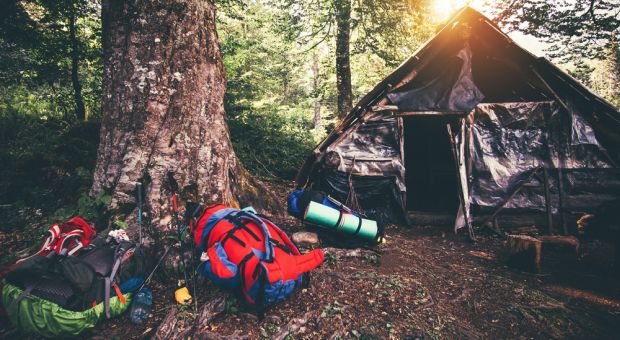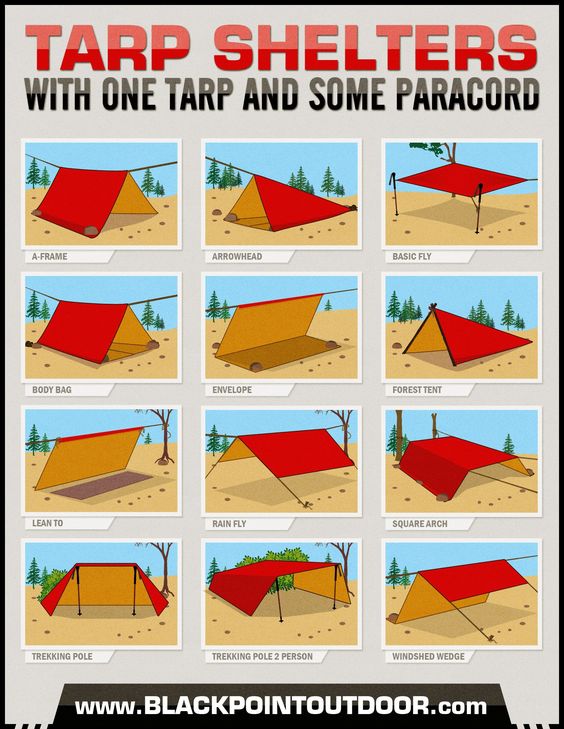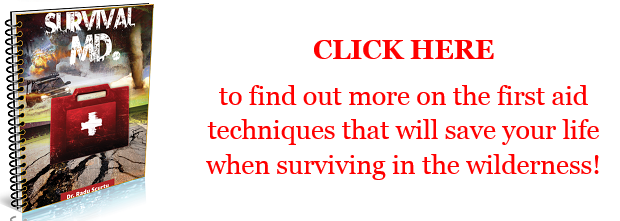What makes an effective tent for survival purposes?
There are a lot of tents out there and choice span continuums of size, cost, durability and taste, but here we are talking about survival. At its core, the job of a tent is to protect its occupants from exposure, but there are many other factors that must be considered when choosing tents for survival needs.
Choosing a Tent that Meets Your Needs
The number of options in the tent market can be a little overwhelming, and not just for first time shoppers. Some of the features save lives and some just sell tents, so I’ll list some of the more important factors and features to consider when choosing a tent that is useful for survival.
Factors to Consider
There are a great many factors to consider and nearly all of them are interrelated to some degree.
- Cost – Survivalists generally must work within certain financial and time constraints in buying or building a tent. The bigger budget you have, the more options there are, but a tent can be had at any budget. Villages of tents pop up after catastrophes even in the very poorest parts of the world. Some refugee camps feature high-end tents and some use tents built from scrap, but they all serve essentially the same purpose.
- Niche/Purpose – A great tent for one purpose may be a lousy choice for another. What will the tent be used for? Is it to get home, bugout, live in long term, or shelter you once you arrive at a location? A combat vehicle crew tent is great for its intended purpose, but a lousy choice for backpacking in the jungle where you would be more comfortable in a hammock with a rain fly. On foot in a SERE scenario, you may want an ultralight one-man survival shelter that can also serve as a poncho or a coat. In cold weather in the mountains, the ability to use a stove inside a lightweight tent is of utmost importance.
Within reason, a tent can be multipurpose. I have tents that are great for survival and great for camping too, but I wouldn’t take a brightly-colored tent into a situation where it would constitute a security risk. Bright colors are good for signaling and getting found but not for hiding. Choose features that give you options instead of limiting options.
- Capacity – How many people will the tent sleep? Will they be lined up like so many sausages on the floor or in cots? Will some of your gear be in the tent with you? If so, you need to plan for that.
- Durability – How long does the tent need to last and under what conditions? Is the tent just going to be used once and thrown away or will it see decades of use? How often will it be camped in? How well will it be cared for and handled?
- Portability – Size and weight constraints for a SERE shelter are very different than for vehicle crew tent or for a tent intended to stay at a campground that gets setup and stored on site. If a personal SERE tent is not very small and light it will get left behind and be useless. How much space can the tent take up and how much can it weigh? Will it be carried in a pack, on a sled, on a pack animal or in a vehicle? Portability affects everything from the tent itself, to stakes, lines and ground sheets.
- Environment – Will your tent need to protect you from snow storms in the Rockies, sand storms in the desert, or rain in the jungle? Humid environments require increased breathability. Cold weather requires a way to heat the tent. In hot weather the tent must be able to keep you cool and offer shade.
- Height – Taller tents are comfortable because you can stand up and walk around and change clothing, but they are also more easily observed. Increased surface area also makes them more vulnerable to severe weather.
- Wind Resistance – Wind is a big deal with tents and different designs deal with wind in different ways. Generally, the more poles a tent has and the lower it is to the ground, the more resistant it will be too wind.
- Snow Load – Operating in snow country requires a roof that sheds snow. Otherwise it can build up and leak or collapse the tent.
Features to Consider
- Snow or Sod Skirt – While blizzards and sandstorms are generated by radically different weather, they both have high winds that can blow matter up under a tent’s rain fly and right up the wall of the tent, and if they top of the tent has mesh vents, fine dust or snow can rain down inside the tent, coating everything inside. It is just maddening. A snow or sand skirt is a skirt of extra material on the rain fly that is buried
- Stove Jack – A stove jack is a heat-resistant feature that enables a stove pipe to penetrate a tent wall or roof and is recommended for many tent styles if a stove will be used inside the tent. Tent stoves are a lifesaving feature in cold climes and reduce humidity inside tents which can lead to condensation inside the tent. Without a stove, the tent must be ventilated to reduce condensation, which gives the occupants a choice between being wet or cold.
- Rain Fly – Many tents suspend a fly off the inner wall. The fly sheds rain. Depending on the material, if an object inside a tent touches the wall of a tent while it is raining, it will often draw moisture through the wall via capillary action. Light tent fabrics are especially vulnerable to capillary action and more water-resistant tent fabrics tend to be heavier, so a fly helps keep the interior dry without adding a lot of weight.
- Blackout Fly – It is important that flies on some military tents block as much light as possible so that the occupants can use a weak light to find equipment or study a map without turning the tent into a beacon.
- Floor Liners & Ground Sheets – Where possible, I prepare the ground well to eliminate rocks, sticks, cactus spines and other objects that damage the floor. I also level the spot if necessary. Then I set down a ground sheet and pitch the tent on top of that. For larger tents, I also add a floor liner inside the tent to increase resistance to puncture by equipment, cot legs or gear.
- Reversible Fly – Some tents have reversible flies with a lighter camouflage or earth tone on one side and a darker shade on the other to blend into more than one environment. A reversible light-dark fly can also be used to warm or cool the tent.
- Number of Doors – Doors add weight and cost to tents but also add capability. I have a couple of combat vehicle crew tents that have four doors, one on each wall of the tent. This enables doors or windows to be closed and opened to catch a breeze and is handy because additional tents can be attached on any of the four sides creating sort of a modular building with rooms that can be opened or sealed off. Personally, I like having a door on each wall because it gives me more exits in an emergency. If necessary, use a knife to make another door to get away from a bear or two-legged predators.
- Bathtub Floor – A bathtub floor is a floor for more waterproof material that extends several inches up the side of the tent wall to prevent water from entering from the ground via capillary action or runoff and is a useful feature on some designs.
- Insect Netting – Insect netting is built-in to some designs and added separately to others. It is a must-have in the jungle and anywhere insects are out in force. You can also use a mosquito bar to enclose your cot or the area where you sleep.
Proper Use
The effectiveness of any tent is greatly impacted by the skill, alertness and proactivity of the people pitching and maintaining it. A top of the line tent can get shredded by severe weather if it is not properly pitched and battened down before the storm hits. How well any tent takes care of you is largely determined by your skill in pitching and maintaining it. I have had a properly pitched and battened down combat vehicle crew tent survive a verified micro-burst with only a snapped guy line and a torn guy loop on the fly. I also saw that same microburst carry a way more a dozen tents that were not properly pitched.
Just remember though, that a tent is merely a tent, after all, and you cannot expect it take severe weather in stride the way a brick building should. If you are camped in a tent and see severe weather coming, get your family and yourself into a sturdy building or a vehicle if one is available instead of trying to ride it out in a tent.
You control many factors that impact the efficacy of your tent. Where you pitch it, how it is oriented, whether you dig a trench to carry away runoff, whether the lines are tight enough, whether it is properly staked for the soil it is in, how well your prepared the ground before you set up the tent … all of these factors affect your comfort, how long the tent will last and how well it will perform.











Kevin Boone | September 16, 2018
|
Anyone have one of the Teepee tents I been seeing online? I’m in Florida and the weather is cool in winter and hot the rest of the year. Winter is maybe 2 days. LOL Anyone have one and are they any good?
Dannysea | September 17, 2018
|
Have seen them for sale on eBay and Amazon, but are made with tent materials and components. My niece had one, simple to put up as it only has one single center pole. They were available for up to 10 people several years ago, but I know very little beyond that. She and her kids were very warm in it, as they used it during our two-day winter here in Florida.. (Hah!)
gRanger Rick | September 16, 2018
|
This is a great article. Thank you for sharing this information. I have forwarded it to the groups I train.
Ranger Rick
Automatic Survivor / President / Chief Instructor
North Idaho
Bill in Idaho | September 17, 2018
|
Hello, CVP. I was quite surprised to find that you never mentioned the Vitally Important Task – of Location for your tent site ! This is probably the most important consideration of all ! Always make your choice as follows : Absolutely Solid Natural Barrier – (No holes), adequate size, and properly oriented (for the wind) – to provide the Maximum wind protection. ( A Large root base of a Big uprooted Conifer (tree) is the ideal selection.) Next, a gentle slope (down is to leeward) which is Well Above any Floodwater or drainage. Plus, a site preferably well sheltered by trees – But – Take Care when selecting the site due to possible wind-fall (“blow-downs”) of the surrounding trees. Last item, how close is your firewood source(s) ?
Debbie Ross | September 20, 2018
|
Need help. The question I have is I live in a city , ranch house in a subdivision.. show would I make my house safe have a basement and could possibly go to a friends house in the country or to CO. I am getting food supply ready. It’s only me and three dogs.
Nicholas Martin | March 28, 2019
|
Thanks for sharing! I’ve chosen a tent with an additional mosquito net for myself. Those mosquitoes are big trouble in our area, especially in summer when it’s warm. Another characteristic which is important to me is how quickly you can set your tent – sometimes you need to make a tent really quickly.
Gary Sackman | August 14, 2019
|
The only time I had to use a tent was on fishing trips and the wonderful “pup” tent in the US Army. Except for the weight (it takes two halves to make a full tent), the tent did what it was intended for. If anyone wants a full selection of tents, from single user up to and including expedition wall tents, Sportsman’s Guide has a complete selection. Standard weekend tents and military issue enclosures. They also have the “Tepee” tents mentioned in a comment earlier. Three different sizes and all are subdued in an olive color. A selection of pick-up truck tents is also included. I would image the purpose for the tent and weight will be key items in selecting a tent. Hiking would indicate a lightweight tent and the ability to drive to the campsite will allow more choices. Keeping safe and dry is the goal.
John Richardson | August 14, 2019
|
A good tip is to have a wheelbarrow if you have to do a runner it takes the strain of carrying your survival equipment and can be used in so many ways, think about this use your survival skills and imagination
Alex | June 19, 2020
|
Tarp and hammock with bugnet for me. Light, quick and efficient. Holds well in wind and rain, even in storms. All 4 seasons with adjustments in clothing, sleeping bag and liner. Protects the bag and gear. Of course for longer periods a shack or brick house would be necessary. Can’t be a lone wolf camping and bushcrafting for long periods, it’s unattainable and unrealistic even for experts.
SOS Products | March 24, 2022
|
The size and weight of a tent are something to consider when you’re out in the wilds. Big tents can be good for shelter or storage, but they also have their drawbacks depending on your needs as well! Can you tell me the best material of tent that should use in wildlife?